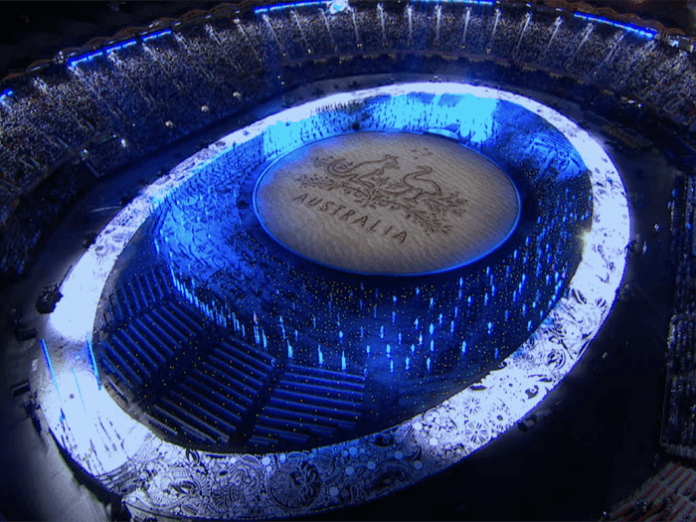For the opening and closing ceremonies of the Gold Coast 2018 Commonwealth Games, The Electric Canvas, an award-winning Australian company specialised in large-scale projections, managed the AV projection relying on Modulo Pi’s high-end media server: Modulo Kinetic.
The 21st Commonwealth Games took place in April 2018 at the Carrara stadium in Queensland, Australia. Produced by Jack Morton Worldwide, the opening and closing ceremonies were spectacular shows with 4.000 volunteer performers. Combining theatre, dance, and music, the shows were created to reflect the Gold Coast culture, embodying its spirit and its energy.
After winning the tender, The Electric Canvas prepared the event over 6 months. To achieve such a large-scale video projection in the stadium, they chose 20 Christie Lites Boxer projectors, as well as Modulo Kinetic, a powerful media server with advanced features from Modulo Pi.
Peter Milne, Director of The Electric Canvas, explained: “I’ve been involved with Yannick Kohn – founder of Modulo Pi – and his technology for nearly 20 years now. When he launched Modulo Pi in 2010, we were very keen on adopting his latest system, Modulo Player”.
Recognised internationally as a leader in large-scale and architectural projections, The Electric Canvas has relied on Modulo Player for several years now: “We use Modulo Player on many projects because we really like the X-map among other features.”
When entering the bid for the Gold Coast 2018, Peter chose Modulo Kinetic, Modulo Pi’s new media server solution: “We were very excited when Modulo Kinetic was launched, and now we have quite a lot of Modulo Kinetic servers. In fact, when we proposed Modulo Kinetic to the Commonwealth Games, we only had a few months experience with it. That was possible because we trust Modulo Pi when it comes to this type of software development. We were sure that their technology would be reliable and solid because of our previous experiences with Modulo Player.”
Working closely with the content producer, The Electric Canvas designed the projection overlay which determined how to cover the field of play, and how to project the other elements efficiently, while providing maximum creativity.
The main video projection was a visualization of Earth and its history, projected on the stadium playfield. This came with several challenges: “We had to put the 20 video-projectors at a height of 67 meters above the ground in the sports lighting towers. We did this because the stage was covered with sand, so there would have been a lot of unwanted texture, had we projected from a normal setting position. Especially as the sand was being constantly disturbed by the performers. Putting projectors so high was a difficult thing to do, particularly for technicians, who had to climb more than 200 steps every day to get to the top of the towers. But it was all worth it in the end, as the resulting image quality was very good” commented Peter.
To handle all necessary changes, the flexibility in the video-projection programming brought by Modulo Kinetic was a must for both ceremonies of this major event: “Ceremony production is a very unique process. There are changes in the choreography or content every day, so you have to have a very flexible system to be able to cope with those changes and incorporate them, sometimes even within the same rehearsal.
“In a time-critical context, The Electric Canvas’ operators made the best of Modulo Kinetic’s capability to preview the show in 3D: “During the day, when we don’t have the benefit of darkness, we can run the show from the recording of the previous evening, using video of the rehearsal, to then further fine-tune the programming of the projection.”
The show also included 3D mapping on Migaloo, a 30 meters long inflatable white whale, handled by 12 puppeteers. The whale floated into the arena, with content projected onto it after it reached its final position. The projection on the whale then transferred to the field of play at the end of the sequence.
The show video was synchronized to timecode, which was delivered with the music, but sometimes had to run independently from the timecode, as Peter explained: “In the case of having to hold entries and exits by the cast, or other unplanned factors, you need programming strategies, creating loops in the content so you don’t have any unexpected result in the picture when the timecode stops, or when something unexpected happens in the show.
There are a lot of media servers who don’t cope with this very well. Having a strategy whereby you can, at some point in the music, ignore the timecode, allowing the music to stop and to loop, waiting for something else to happen when there’s a mechanical breakdown on the field, or when somebody falls over, is crucial. These contingent loops are a major and important part of these live shows, so having a system like Modulo Kinetic that deals with those contingencies, in a very fluid and flexible way, is essential.”
Operators could also rely on the backup capabilities of Modulo Kinetic: “On a show this size, you have many departments involved, with everybody running from the timecode. One other important feature of Modulo Kinetic is the automatic reversion to back-up systems, should we have a computer problem or failure. That is also something Modulo Kinetic is good at.”
Peter concluded: “It was reliable, flexible, and easy-to- use in a situation that can sometimes change dramatically every day. The Modulo Pi media servers are very specifically built for technicians and for the creatives that do the type of work that we do. Because the Modulo Pi team listens to technicians and creatives that work on projects, they modify and improve their software specifically on that feedback. For us, that’s an enormous advantage compared to other much larger companies.”


